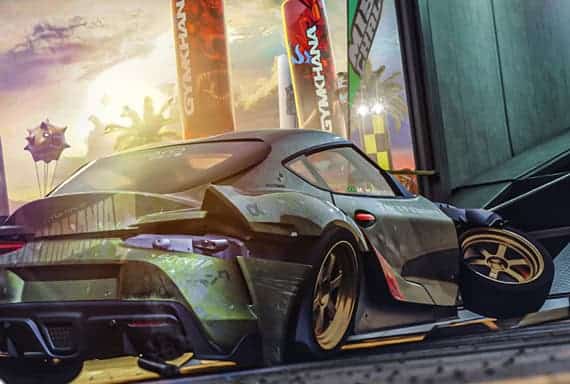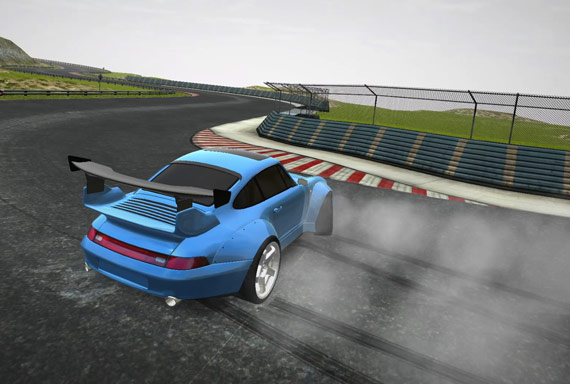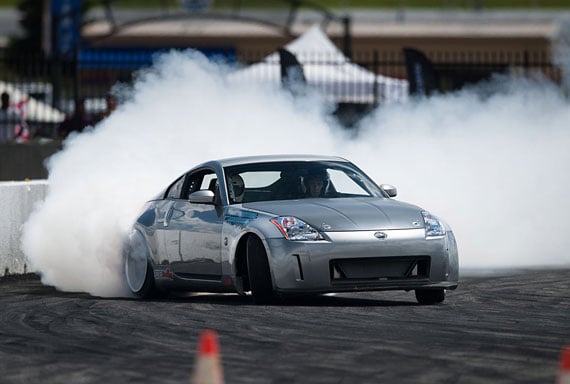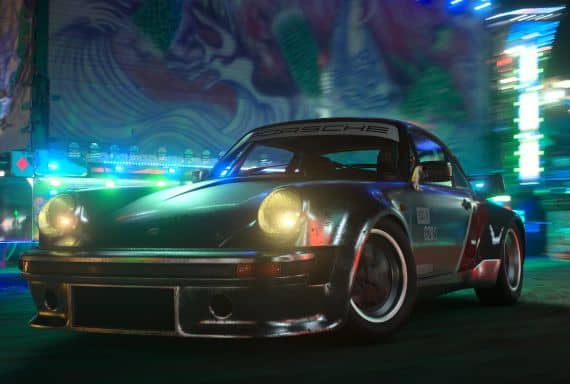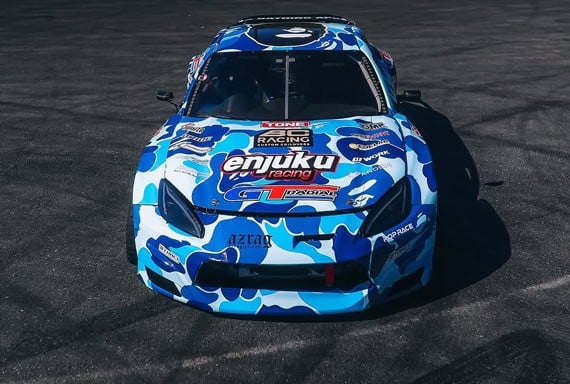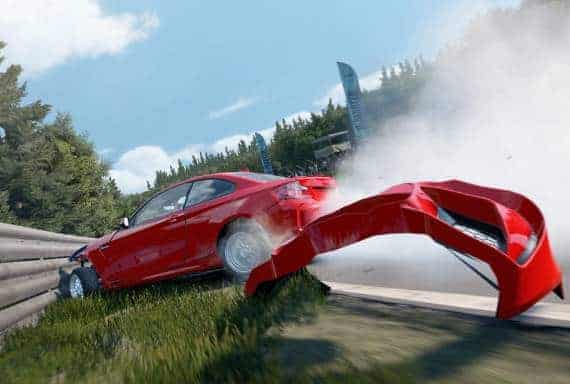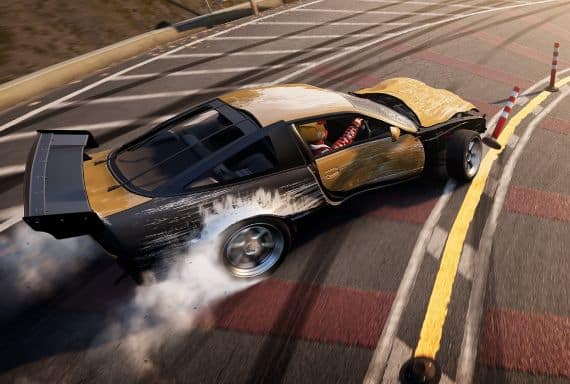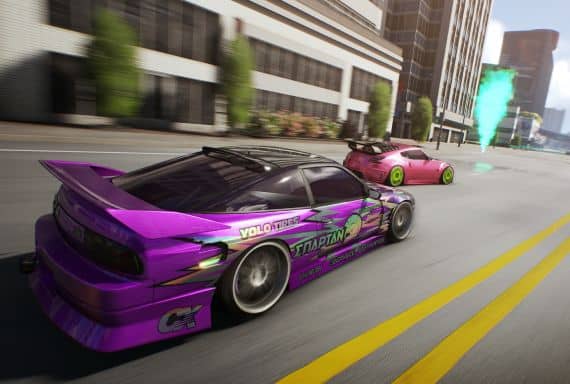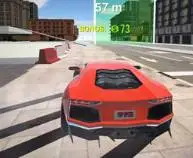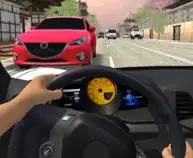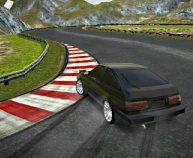Ultimate Forza Horizon 5 Drift Tune Guide
A good drift setup can help you top the leaderboards or tandem with your buddies. Here are our recommended settings for the ultimate Forza Horizon 5 drift tune.

Jump To Section
Introduction
Sequels are all about progress, right? Why bother with a second take if you’re not gonna do better than the first time around?
Thankfully, Playground Games crushed it with Forza Horizon 5, the follow-up to the already-awesome FH4. PlayStation players can now (finally) join the party, too (we never thought we’d say that!)
Forza Horizon 5 builds upon Forza Horizon 4’s proven and tested formula and cranks it up a notch. Tons of races, epic graphics, the biggest in-game car selection in drift gaming (almost 900 cars!), and the addictive drifting experience we all crave.
Plus, you can enjoy all this while soaking in Mexico’s breathtaking scenery!
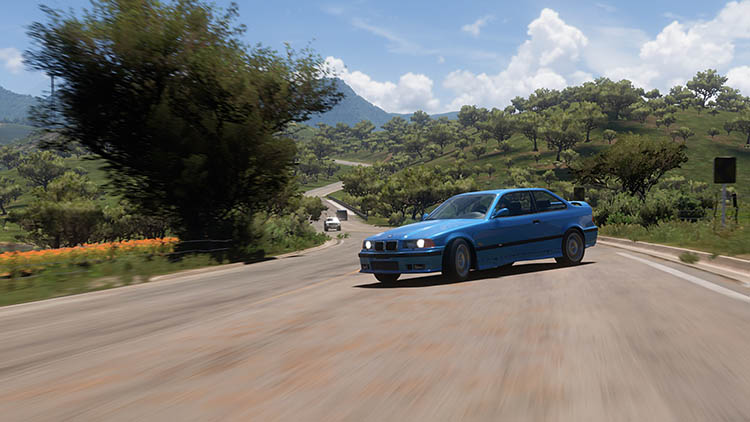
Drifting is arguably the biggest reason the Forza Horizon series dominates the racing game scene. It delivers satisfyingly easy-to-get-the-hang-of sideways action that’s hard to find elsewhere.
While dedicated drifting simulators like Assetto Corsa and iRacing deliver incredible realism, they require serious patience and dedication to master (and good luck trying to do that with just a controller or keyboard!).
Forza Horizon’s physics strike the perfect “simcade” balance between simulation and arcade. They’re forgiving enough that casual players can have a blast going sideways without wanting to throw their controller through a window.
If you want to level up your drift game in FH5, you’ve come to the right place. This Forza Horizon 5 drift tune guide will help you learn how to create the perfect setup that matches your driving style. Let’s get sideways!
Driving Assist Settings
Firstly, let’s take a quick look at the boring basics of Forza Horizon 5’s driving assists. These settings can truly make or break the drifting experience, so we recommend paying close attention and ensuring you don’t skip this part!
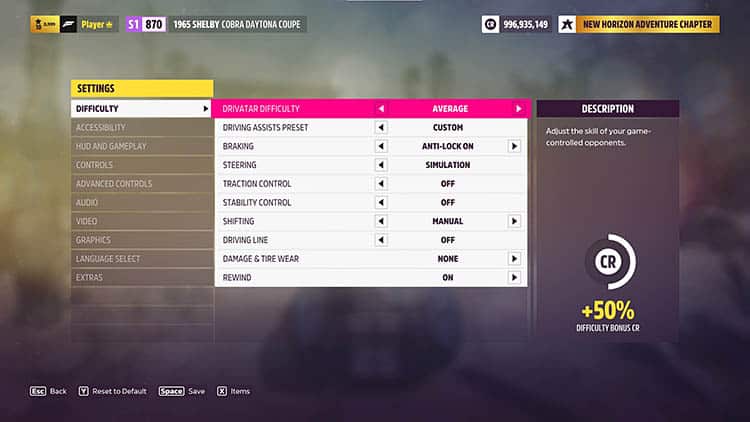
Braking – (Anti-Lock/ABS) – Off (Mostly)
ABS (Anti-lock Braking System) is like training wheels for your car’s brakes. But when you’re trying to get sideways, those training wheels will likely just get in the way.
For beginners: You can consider keeping ABS ON at first, as it won’t make your break your drifting potential. It’ll potentially save you from locking up and spinning out when you panic-brake (trust me, you will). However, aim to turn this off once you get more comfortable behind the wheel.
For experienced drifters: As you probably guessed, you want to turn the ABS OFF immediately. This will give you full control over your braking, essential for maximizing angle and proximity when nailing the sweet door-on-door tandem drifts.
Keyboard users: Stick with ABS ON. You can’t modulate brake pressure with keys, anyway. We highly recommend investing in a controller or wheel setup as soon as possible to maximize FH5’s drifting potential.
Remember, no ABS means your car will be trickier to control, and you’ll need to learn how to use various braking pressures instead of pressing the brake pedal like a button!
Steering – Standard/Simulation
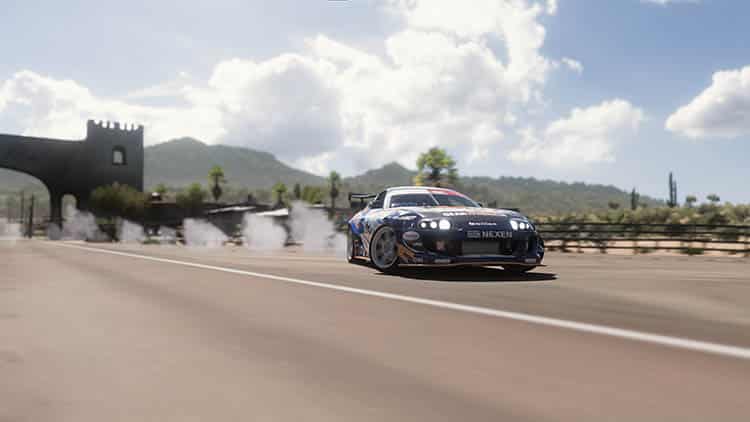
Standard or Simulation are both popular choices, but for different purposes.
Wheel users: ‘Simulation’ is your best bet here. It’ll give you better feedback through your fancy setup (and make you feel like a proper drift king!)
Controller/keyboard users: ‘Standard’ is recommended for most situations. You can try ‘Simulation, ‘ but you’ll most likely realize it doesn’t make much sense with a controller.
If you’re already comfortable with one of these, stick with what’s currently working, especially if you’re already nailing the backward entries, as the other setting is likely to feel VERY different.
Traction Control – Off
Traction Control and drifting mix about as well as oil and water.
Under normal driving situations, Traction Control is designed to keep your tires gripping the road at all costs. But in drifting, we always want those rear wheels spinning freely.
With Traction Control on, your car will stubbornly refuse to drift, no matter how much horsepower you’re packing or how hard you try (we’ve all seen the drifting fail YouTube videos).
Always turn it OFF, whether you’re a beginner or advanced player – embrace the chaos!
Stability Control – Off
Stability Control is basically Traction Control’s overprotective big brother. It’ll try desperately to keep your car pointing straight when all you want to do is go sideways.
Turn this OFF too. It’ll make initiating drifts much easier and give you maximum control over your slide. Your car might feel a bit twitchier at first, but that’s exactly what we want for drifting so that we have full control over the car.
Shifting – Manual
Ever wonder why pro drifters sound like they’re trying to murder their engines? They’re keeping the revs high to keep the wheels spinning and the car sideways.
Automatic shifting is (typically) programmed to upshift at the earliest opportunity. This lets the rear tires grip up. – forcing the car to go straight. Not cool when your goal is to spin up the rear wheels!
Manual shifting, on the other hand, lets you stay in the optimal powerband and gear to keep the tires spinning happily.
Switch to Manual as soon as you feel comfortable with the basics of getting sideways.
Once you’re ready to unlock the maximum potential, opt for the manual clutch, too. This will be hugely useful for advanced drifting techniques such as backward entries and tandems.
Driving Line – Optional
The most basic Driving Line – out-in-out – is generally the fastest way around any corner. In road racing and rally events, the Driving Line setting can help beginners find the best line for the fastest lap times in Horizon 5.
It can also be helpful for drifting, especially when you’re learning.
In FH5, maintaining a higher speed while drifting provides more drift points. The driving line can show you the fastest way through the corners, translating to more points and bigger grins!
Beginners: Consider keeping it on while learning the ropes and figuring out entry/drift initiation speeds.
Advanced: You can turn it off once you feel more confident and ready to prove you’re the true Drift King!
Damage & Tire Wear – Off
Generally, we feel that Damage and Tire Wear is an awesome feature in Forza Horizon 5. After all, it adds some much-needed realism to an otherwise arcade-esque racing game, but it’s more useful for racers than drifters.
Although real-world drifters must deal with tire wear, it’s not optimal when drifting in Horizon. It introduces too much variance in overall grip over time, and we’re sure real-world pro drifters would prefer not to deal with this, too!
Given the choice, it’s better and more predictable for grip levels to remain constant throughout sessions.
One of the main perks of playing a game instead of shredding real-world rubber is not having to worry about buying, transporting, and replacing tires.
So, whether you’re a newcomer or a Horizon pro, we always recommend turning Damage & Tire Wear OFF for a more consistent, enjoyable Forza Horizon 5 drifting experience.
Rewind – Optional
The Rewind feature is like a time machine for your mistakes. Missed the perfect entry? Rewind. Smashed into a wall? Rewind. Accidentally drove off a cliff while trying to be Ken Block? Definitely rewind!
For beginners new to drifting in Forza Horizon 5, it’s an absolute godsend. You can practice without the frustration of long resets or restarting an entire drift zone.
However, try to rely on it less as you improve, but keep it handy for those “How did that even happen?” moments we all have.
Now that your assists are dialed in properly, you’re ready to start laying down some virtual rubber on Mexico’s roads.
Remember, practice makes perfect – so it’s time to get out there and start sliding!
Getting Started With Forza Horizon 5 Drift Tunes
In this section, we’ll help you decide whether a pre-tuned drift setup or a custom-built setup is the best option.
Community Drift Setup vs Custom Horizon 5 Drift Tune
Playground Games made drift setups easy to share and download in Forza Horizon 5 by allowing users to create “Share Codes”.
Downloading your friends’ or favorite YouTuber’s Forza Horizon 5 drift tune is as easy as browsing through the community setups and downloading a ready-made drift tune. This applies whether you want a basic setup or an easy, quick way to drift some of the rarest cars in the game.
But there’s a slight catch – the community Horizon 5 drift tunes have serious limitations. You can’t see or modify any settings in a downloaded tune.
Want to tweak the differential a bit? Sorry, not happening. Think the suspension is too stiff? Too bad! You’re stuck with exactly what the creator made, for better or worse.
Another downside is that community Horizon 5 drift tunes are often built for specific driving styles. That S15 tune with 50,000 downloads might be perfect for the creator’s aggressive clutch-kick style, but it could feel completely wrong if you prefer smooth, throttle-controlled drifts.
They might have also made it optimal for a wheel setup, where you might use a controller. You get the idea. They’re designed with specific needs in mind and might not match yours.
Why You Should Create Your Horizon 5 Drift Tunes
With community tunes, you’re missing out on the learning experience and the opportunity to improve your drifting knowledge. Creating your own unique Horizon 5 drift tune teaches you how each setting affects your car’s behavior, making you a better driver across all disciplines.
Drift setups are a matter of personal preference. The ideal route for drift setups in Forza Horizon 5 is to start with a great base drift tune and then learn how to tweak it to suit your specific needs and drifting style.
We’ve outlined some must-have upgrades and settings for building the ideal drift car in Forza Horizon 5. You can use these as a base drift tune/setup that you can slowly tweak to make drifting any car more enjoyable in-game.
Before going crazy buying car upgrades and aimlessly tweaking your car’s settings, we recommend checking out this Forza Horizon 5 drift tune guide by HokiHoshi. It explains what you need to know about drift upgrades and tuning in Forza Horizon 5.
Now that you know why certain parts and upgrades were chosen for this guide, we can move on to the next section, where we upgrade and tweak your chosen car for the best possible drift experience in Forza Horizon 5.
Must-Have Drifting Upgrades For The Best Forza Horizon 5 Drift Tune
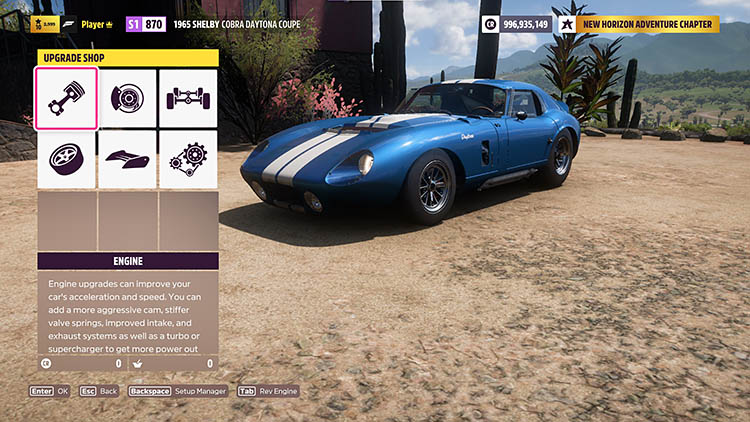
Of course, to get started, you’ll need a good base car. If you’re unsure what to pick, we recommend looking at the best drift cars that Forza Horizon 5 has to offer.
Engine
Depending on how much power your base car has in stock form, you’ll ideally want to keep maximum engine power under 600 horsepower. Why under 600? Doesn’t more horsepower equate to more performance?
This is because cars with more than 600 horsepower can be more difficult to control when drifting in Forza Horizon 5, especially if you’re new to drifting.
That said, most cars with 300 horsepower in stock trim will end up with around 500-600 horsepower after you’ve set every Engine upgrade to the “Race” option.
- Intake: Race Intake
- Fuel System: Race Fuel System
- Ignition: Race Ignition
- Exhaust: Race Exhaust
- Camshaft: Race Cams
- Valves: Race Valves
- Displacement: Race Engine Block
- Pistons/Compression: Race Pistons/Race Compression
- Turbo: Best Turbo Option Available
- Intercooler: Race Intercooler
- Oil/Cooling: Race Oil/Cooling
- Flywheel: Race Flywheel
If you’re not new to drifting, consider going beyond 600 horsepower. But it’s best not to chase huge power figures when starting, as the car becomes more difficult to control.
Platform & Handling
Having tons of power to start and initiate drifts will not mean much if your car can’t transition quickly or stop on a dime. Therefore, we now turn to brake and suspension upgrades so you can easily control your base car’s newfound power.
- Brakes: Race Brakes
- Spring and Dampers: Drift Spring and Dampers
- Front Anti-Roll Bars: Race Front Anti-Roll Bars
- Rear Anti-Roll Bars: Race Rear Anti-Roll Bars
- Chassis Reinforcement/Roll Cage: Race Chassis Reinforcement/Race Roll Cage
- Weight Reduction: Race Weight Reduction
Drivetrain
With the Race-grade upgrades you have installed, your base car will push upwards of 400 horsepower. You must ensure its Drivetrain components can keep up and effectively put power to the ground. Otherwise, all those power gains will go to waste.
- Clutch: Race Clutch
- Transmission: Race Transmission
- Driveline: Race Driveline
- Differential: Race Differential
Tires and Rims
The type of Rims you install on your drift car won’t matter much since the weight savings between models are only marginal at best. So for rims, go purely based on looks, and choose the one you like the most.
Take it from us – you sure can’t go wrong with any of the Work Meister wheels, which are thankfully one of the many options featured in FH5!
However, Tires are a completely different story; you will want a wider rear tire relative to the front. This ensures maximum grip at the back, which is vital in drifting.
Tires
- Tire Compound: Drift Tire Compound. If Drift feels too grippy, you can also try Sport/Stock tires, but avoid Race tires as you’ll struggle to break traction.
- Front Tire Width: Keep narrow – we recommend stock or -1 level from stock. Narrower front tires reduce front grip, promoting easier initiation and angle correction. However, if you go TOO narrow, you might spin out.
- Rear Tire Width: This depends on power, but we recommend going slightly wider than stock (+1 or +2 levels). Consider trying more for big power. The objective is to provide enough grip to maintain control without catching too much traction.
Wheels
- Front Rim Size: Keep the stock Front Rim Size stock or go +1
- Rear Rim Size: Keep the stock Front Rim Size stock or go +1 (Match the front rim size for balanced handling)
Aero and Appearance
Aero upgrades won’t be as beneficial when drifting as in road or circuit racing. After all, your drift car will spend most of its time sideways, rendering big downforce rear wings and front splitters almost useless.
So, choose the Aero parts (such as the widebody kits and wings) you like the most, and see them purely as cosmetic Appearance upgrades. Bonus points if it gives off the best “drifter” vibe so you can drift around in style in Forza Horizon 5!
Tuning Your Drift Car In Forza Horizon 5
With all of the necessary upgrades installed, every parameter on your drift car should now be fully adjustable.

To take full advantage of the upgrades you’ve just installed, you have to tune some settings to make your drift car behave more predictably and forgivingly, just like you’d expect to tune a real-life skid car.
These Tuning settings will provide a balanced drift car setup for Forza Horizon 5.
Differential
The differential (diff) allows your car’s wheels on the same axis to rotate at different speeds. If you’ve ever seen someone trying to do a burnout (or fail at drifting) with an open differential, it’s usually called a “one-wheel peel” and is embarrassing.
For drifting, you want to stop the rear wheels from being able to do totally different things from one another to ensure power is delivered equally to both. Locking them together is perfect for breaking traction.
In this case, the easiest and fastest way to ensure that your drift car can continue sliding sideways is to simulate a “welded-diff” or Limited Slip Diff (LSD) setup.
This will ensure that your car’s rear tires spin up simultaneously, removing the possibility of random grip-ups when you least expect them.
Differential Settings
- Acceleration: 100%
- Deceleration: 100%
When your differential is set to 100% for both acceleration and deceleration, it forces both rear wheels to spin at identical speeds, regardless of the corner.
Maintaining the 100/100 setup is especially important for lower-powered cars to help break traction.
If you’re running 600+ HP, consider lowering the acceleration differential to around 95-98% to prevent excessive wheelspin.
Braking
In Forza Horizon 5, especially when you’re getting started, you’ll typically use the e-brake to initiate your drifts, while your drift car’s normal brakes are used more to slow your pace down mid-drift rather than start.
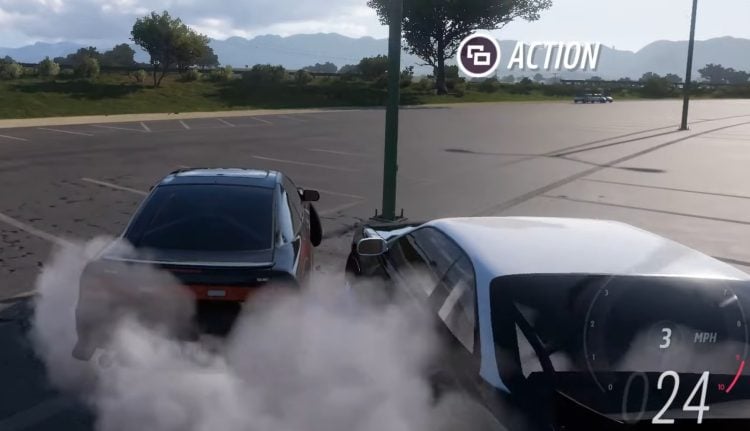
This is especially important for tandem drifts, as you want to maintain a consistent distance from your drift partner (or rival!) while navigating the corners. Quick taps of the e-brake (combined with careful feathering of the front brakes) allow you to practice precise proximity.
Without a properly set-up brake balance and braking force, your drift car will often want to straighten up when braking rather than slow down mid-corner, which isn’t ideal when your goal is to keep your drifts going for as long as possible!
Brake Setup
- Braking Force Balance: 0% – Pushes all braking force to the front wheels to keep the rear wheels spinning.
- Braking Force Pressure: 30% – When braking, 100% would make the brakes feel like a “switch” rather than a pedal. We find 30% optimal for brake pedal control during tandems and close-proximity runs.
Aero
As mentioned earlier in this article, Aero doesn’t contribute much to drifting.
However, if you want to, a slight front downforce tweak can help make your drift car’s front end (very slightly) better at initiating and transitioning.
- Downforce Front: Stock or increase +5-10 – Too much downforce can make initiating more challenging.
- Downforce Rear: Keep stock setting – Optimal for breaking the rear-end loose and predictable momentum once sideways.
Damping
Front damping should be moderately stiff to maintain steering control, while rear damping should be slightly softer for optimal weight transfer during slides.
- Rebound Stiffness Front: Keep stock setting
- Rebound Stiffness Rear: Keep stock setting
- Bump Stiffness Front: Set to 50% of stock Front Rebound Stiffness setting
- Bump Stiffness Rear: Set to 50% of stock Rear Rebound Stiffness setting
Avoid extreme settings (max or zero) as they’ll create unpredictable behavior.
Test with the settings above, and then make minor adjustments until you find the perfect balance between responsiveness and stability.
Springs
A stiffer front spring setting will reduce front-end grip, which makes maintaining your desired line difficult while drifting.
On the other hand, stiffer rear springs can also make the rear less controllable and cause the car to oversteer when opening up the throttle.
Keeping the front springs stock and reducing the rear spring stiffness will usually make your car more controllable when drifting.
- Springs Front: Keep stock or increase a little
- Springs Rear: Reduce a little from stock setting and use small adjustments until you find the perfect grip level
Reducing the rear spring stiffness gives the rear more grip. Don’t panic about the rear tires gripping up too much since your car should now have enough power to spin the rear tires regardless.
Again, small adjustments are key, and don’t go too crazy either way to start. Testing is key.
Ride Height
The Drift King, Keiichi Tsuchiya, once said, “Speed isn’t everything; you gotta look cool on the touge, too.” We wholeheartedly agree!
However, some cars may frequently bottom out if they’re too low. Other times, the wheels might get completely lost in the fenders or hit them if they’re poking out too much, so try to avoid that.
- Ride Height Front: Minimum
- Ride Height Rear: Minimum
Keep ride height to a (reasonable) minimum without sacrificing performance (hitting the ground mid-drift isn’t ideal!).
This will reduce body roll and help make your drift car feel more responsive on switchbacks. In addition, you’ll (finally) look cool on the touge!
Antiroll Bars
Anti-roll bars (ARB) affect handling similarly to changing Spring settings. ARBs specifically target lateral (side-to-side) movement, making it easier to control when drifting.
To start with, keep the Front ARB settings stock and reduce the Rear ARB slightly for more control. If your car doesn’t have enough power, try stiffening the Rear ARB to help your car’s rear tires break traction more easily.
- Front Antiroll Bars: Stock
- Rear Antiroll Bars: Set a few clicks softer than Front ARB
Alignment
Your car’s Alignment settings will influence how your drift car behaves more than the rest of the settings above ever will.
The most important settings of the bunch will be Camber and Caster, as these two settings will give your drift car the necessary angle it needs to sustain drifts with minimal effort.
- Front Camber: -5º – If you struggle with maintaining straight-line grip when not drifting, try opting for -3 to -4º.
- Rear Camber: 0º to -0.5º – Add more rear camber (negative number) if you want to reduce the rear grip – we don’t recommend going beyond -0.5. Reduce for additional rear grip.
- Toe Front: 1.0º —Consider upping to 1.5º, but observe how this makes the car more twitchy. It’s a personal preference that comes with drifting style and ability level.
- Toe Rear: -0.5º – Consider going closer to -0.2º if you seek a more responsive rear end.
- Front Caster: 7º – A high caster setting increases the car’s self-centering and steering angle. Small adjustments can be made, but this is typically the sweet spot.
Gearing
Gearing requires a little more manual adjustment for drift setups, varying from car to car and engine to engine. It often needs minor tweaks to get just right, but the process is straightforward.
To start, take your car out and drift around the streets of Mexico in Forza Horizon 5. Pay attention to the two gears you use most for drifting (for example, 3rd and 4th gear).
If you’re constantly bouncing off the limiter in these gears, lengthen them by lowering their ratio values, or move the final drive toward “speed” to make all gears longer and prevent constant redlining.
If a gear feels too slow or sluggish, shorten it by raising its ratio value for more acceleration.
After setting your main drift gears, adjust the higher gears (5th, 6th, 7th) so each is slightly longer than the previous, ensuring smooth RPM transitions as you shift up.
Test your car after each change to ensure the gearing matches your drift style and your engine’s powerband.
If you’re looking for a more in-depth explanation, check out this video:
Tires
Front tire pressure is not as important when drifting as the rear tire pressure is, but lower values will provide more grip. Once it feels right, leave the front tire pressure at a constant value.
The more important aspect is the rear tire pressure. You’ll need to tweak and adjust the rear according to how you want your drift car to behave.
Some pro drivers have been known to run as little as 6 PSI (that’s not a typo!), while low-powered cars might opt for the opposite end of the spectrum by running 60 PSI.
For optimal setup, we’ve typically found starting at 25 PSI when cold at the rear optimal, which should reach around 32 PSI when warmed up.
- Tire Pressure Front: 28-32 PSI
- Tire Pressure Rear: 25 PSI
Try the above settings first. Once you’ve tested the setup, lower the pressure if you want more grip at the rear. Increase the pressure if you want less grip.
Once you’ve completed all these tweaks, you’ll have a solid drift car to compete with.
Now that you understand how things work, keep making small tweaks and modifications per your liking. Soon, you’ll end up with the ultimate drift car, leaving your friends asking you to help tune theirs. (You can send them to this guide to save you time!)
After mastering drifting in Forza Horizon 5, you might be tempted to take your drifting to the real world. If so, check out our ultimate picks for cheap drift cars or best drift cars for beginners to discover the perfect starting point.
Conclusion
For now, this base Horizon 5 drift tune should help turn your drift car into a balanced and easily controllable machine, perfect for learning the ins and outs of the art of drifting.
With your newfound knowledge, you can transform even the worst setups into a tandem-ready drift weapon. With enough practice and learning advanced techniques in-game, you’ll be drifting like a pro in no time at all.
As you gain more experience drifting around Forza Horizon 5, you’ll get a better idea of what type of handling you prefer and the setups you want on your drift car.
Knowing which parameters to tweak to get the handling change you want for your drift car will be crucial in creating the best Forza Horizon 5 drift tune for your driving style.
Now that you’ve tuned your drift car to perfection, why not do the same with the fastest drag cars in the game? Or, perhaps you’d rather add the most expensive car in FH5 to your collection?
Or, if you’re looking for something a little different to mix it up, why not try the free-to-play stunt browser game Madalin Stunt Cars 3? We’ve also got a huge selection of other car games you can play for free right now.
If you loved FH5, check out the latest news regarding Forza Horizon 6. If the recent rumors are anything to go by, it could be closer than ever, and we might even finally get treated to Japan!
Thank you for reading our Forza Horizon 5 drift tune guide.
If you enjoyed this article, please share it with the buttons at the bottom of your screen. If you’ve found this information useful, then please take a moment to share it with other tuning, drifting, and Forza Horizon 5 fans. We appreciate your support.


 (10 votes, average: 4.80 out of 5)
(10 votes, average: 4.80 out of 5)




